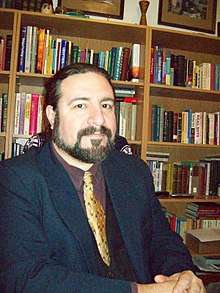Baháʼís Under the Provisions of the Covenant
The Baháʼís Under the Provisions of the Covenant (BUPC) is a small Baháʼí sect founded by Leland Jensen in the early 1970s. The claims of the BUPC focus on a dispute in leadership following the death of Shoghi Effendi in 1957, and a subsequent dispute among the followers of Mason Remey, all of whom were shunned by the majority of Baháʼís. Jensen also made specific predictions for worldwide catastrophes, including a date in 1980 for the apocalypse, where followers were observed by researchers as a study in cognitive dissonance.[1]
Researchers from the University of Montana who observed the group in various studies over the course of 16 years noted that from 1980 to 1996 membership fluctuated, but probably never exceeded 200 nationwide.[2] Adherents were mostly concentrated in Missoula, Montana, with members at times in Wyoming, Arkansas, Minnesota, Colorado, and Wisconsin.[2][3] The group consisted of roughly 150 people leading up to 1980,[4] but declined in size significantly following the disconfirmed prophecy, with almost all of the believers outside of Montana eventually rejecting Jensen's teachings.[5] By 1990 the researchers claimed the BUPC probably had fewer than 100 members.[3] With defection accelerating in the 1990s, they noted that in 1994 a membership phone list showed 66 members in Missoula, Montana, and less than 20 in other states,.[2] A schism over leadership of the group in 2001 resulted in other defections and an unresolved court battle for control of funds. Researchers documenting religious groups in Montana in 2003 noted a community of 30 members in the headquarters of Missoula, Montana.[6]
Beliefs
The BUPC profess adherence to all the writings of the Baháʼí Faith's central figures: the Báb, Baháʼu'lláh, and ʻAbdu'l-Bahá, as well as Shoghi Effendi. The religious differences between the BUPC and the Baháʼí Faith are essentially over leadership, although certain teachings introduced by Jensen do differ greatly. For example, Jensen taught that the institution of the guardianship is the continuation of the Davidic line, an idea that Baháʼís would not recognize.[6]
Guardianship
Charles Mason Remey, one of Shoghi Effendi's Hands of the Cause, declared himself the successor to Shoghi Effendi in 1960. His claim was rejected by his fellow Hands, with the reasoning that he was not a descendant of Baháʼu'lláh, or Aghsan, nor did he have a clear appointment to the position by Shoghi Effendi. Remey based his claim on his being the president of the International Baháʼí Council appointed by Shoghi Effendi in 1951. The result was that Remey and any followers were unanimously expelled from the Baháʼí community by the Hands of the Cause.[7] The Universal House of Justice later announced that it could not appoint or legislate to make possible the appointment of a second Guardian to succeed Shoghi Effendi.[8] Jensen was among the Baháʼís who accepted Remey to be the 2nd Guardian, and to reconcile the requirement that Guardians be Aghsan he believed Remey had been adopted by ʻAbdu'l-Bahá, and further that Remey's adopted son Pepe was the third Guardian, a point denied by Pepe.
Leland Jensen
In 1963 Mason Remey set up a National Assembly in the United States, which was dissolved in 1966. Leland Jensen was among the members elected in 1963, and in 1964 he left the group during a time of disputes among the members and moved to Missoula, Montana.[2] In 1969 he was convicted of performing "a lewd and lascivious act" for sexually molesting a 15-year-old female patient,[2][9] and served four years of a twenty-year sentence in the Montana State Prison.
It was in prison that Jensen claimed to have a revelation, and converted several dozen inmates to his idea of being the "Establisher" of the Baháʼí Faith,[2] stemming from his belief that the administration of the religion had been corrupted, and that he was chosen by God to re-establish the administration.
Disconfirmed prophecies
Jensen began teaching as early as 1971 that in 1980 the world would be cleansed of evil by a nuclear holocaust.[2] Jensen gained national attention when on April 26, 1980 he led a group of followers into fallout shelters, expecting an apocalyptic nuclear holocaust.[1] He went on to predict that Halley's Comet would enter earth's orbit on April 29, 1986, and collide with the earth exactly one year later.[10]
With Jensen's approval, in the early 1990s his companion Neal Chase made a total of 18 predictions which pertained to small-scale disasters that he claimed would lead step-by-step towards the Apocalypse, as well as dates for a nuclear attack on New York City by middle Eastern terrorists.[11] Balch noted that Chase responded to the 18 disconfirmed prophecies with a number of "face-saving strategies",[12] including drawing a distinction between prediction and prophecy, claiming miscalculation, reprieve, and tests of faith. Chase later proclaimed "We didn't make a mistake," and that they have "a 100 percent track record!"[12]
Leadership dispute
sIBC and Joseph Pepe
In 1991 Jensen appointed 12 members to a second International Baháʼí Council (sIBC) modeled on the International Baháʼí Council set up by Shoghi Effendi,[13] and Jensen registered it in 1993 as a non-profit corporation in Montana.[14] He intended for it to evolve into the elected Universal House of Justice with the Guardian as its president. Believing Joseph Pepe was the Guardian, Jensen invited him to be the president of the council, but Pepe steadfastly denied being the Guardian and had no involvement with the group.
Neal Chase

Joseph Pepe died in 1994, leaving no clear candidate for leadership after Jensen's own death in 1996, and no way to appoint new members to the board. Jensen's schism from the mainstream Baháʼí Faith was based on the belief that the religion required a line of appointed hereditary Guardians, and Jensen's chosen candidate for the role was Pepe, who refused to be involved with Jensen's sect.
After Pepe died in 1994 Jensen began hinting that Neal Chase might be the next Guardian.[15] Years later, justifying his claim to leadership, Neal Chase claimed to have been secretly adopted by Pepe.[6]
The long-running dispute about the identity of the Guardian broke the group into schism when Chase claimed the role in 2001.[14] The treasurer of the council responded by declaring Neal Chase a Covenant-breaker, and Chase subsequently claimed that failing to recognize him as the Guardian amounted to Covenant-breaking.[14][16]
The majority members of the sIBC filed a complaint on April 26, 2002, seeking an order granting damages against Chase, including interest and attorney's fees; and an injunction forbidding Chase to represent the council.[14] Chase filed a motion to dismiss on July 15, 2003, arguing that a judicial resolution would require a court to interpret religious doctrine. The motion was granted September 29, 2003.[14] The case was appealed to the Supreme Court of Montana in 2004, and a decision came February 15, 2005,
"Chase argues that the Guardianship, a religious office, vests him with the presidency of the corporation, a secular one, and that it is through holding the latter that he rightfully controls the corporate property. The presidency thus serves in this instance as the temporal nexus between the world of faith, represented by the Guardianship, and the secular world, in which laws define the relationships between persons, corporate or otherwise, and property."
"This dispute revolves around two basic issues: the composition of the Board, and the powers of the presidency in relation to the church property... The District Court has no power either to anoint a successor to any religious office, or to invalidate any claim thereto. If these two issues can be resolved on purely secular grounds, then the District Court can apply corporate, property, and tort law in deciding the merits of the Board's conversion and other claims against Chase."[14]
The case was remanded to the lower court for further proceedings.[14]
Domain name dispute over UHJ.net
On February 24, 2005 the National Spiritual Assembly (NSA) of the Baháʼís of the United States filed a complaint with the World Intellectual Property Organization Arbitration and Mediation Center against Neal Chase for his use of the domain name UHJ.net, which claims to be "The Official website of the Universal House of Justice" - a name for which the NSA has a United States federal trademark registration, issued in 1965.
The case resulted in Chase keeping the domain name on the basis that "uhj" as an acronym is not commonly used in the Baháʼí Faith to refer to the Universal House of Justice. The panel also concluded that the NSA was not attempting a reverse domain name hijacking. All other issues were deemed not necessary to address.[17]
See also
Notes
- Stone 2000, pp. 269
- Stone 2000, pp. 271
- Stone 2000, p. 280
- Stone 2000, p. 132
- Stone 2000, p. 138
- Hyslop 2004
- Smith 1999, p. 292
- The Universal House of Justice, Letter of 6 October 1963, Messages from the Universal House of Justice 1963-1986 p. 14
- State v. Jensen, 153 Mont. 233, 455 P.2d 631 (Montana, 1969)
- Stone 2000, p. 277
- Stone 2000, pp. 272
- Stone 2000, p. 275
- Stone 2000, p. 282 note 5
- Opinion/Order, Montana Supreme Court, 2/15/2005 Case No. 04-214. Cases are accessible online at State Law Library of Montana Archived 2009-04-02 at the Wayback Machine.
- Stone 2000, p. 282 note 6
- Appellant Brief, p. 8, 4/23/2004. Respondent Brief, p. 9, 5/21/2004. Montana Supreme Court, Case No. 04-214. Cases are accessible online at State Law Library of Montana Archived 2009-04-02 at the Wayback Machine.
- See WIPO document
References
- Hyslop, Scott (2004), Pluralism Project, Harvard University Study of Religion
- Rabbani, Ruhiyyih, ed. (1992), The Ministry of the Custodians 1957-1963, Baháʼí World Centre, ISBN 0-85398-350-X
- Robins, Tom (1997), Millennium, Messiahs, and Mayhem, New York, New York. 10001: RoutledgeCS1 maint: location (link)
- Smith, P. (1999), A Concise Encyclopedia of the Baháʼí Faith, Oxford, UK: Oneworld Publications, ISBN 1-85168-184-1
- Stone, Jon R. (ed) (2000), Expecting Armageddon, Essential Readings in Failed Prophecy, New York: Routledge, pp. 269–282, ISBN 0-415-92331-XCS1 maint: extra text: authors list (link)
- Taherzadeh, A. (1992), The Covenant of Baháʼu'lláh, Oxford, UK: George Ronald, ISBN 0-85398-344-5
Newspaper articles
- Bradlee, Eva (24 November 2001). "A Baháʼí perspective on spiritual destiny". The Missoulian
- "Baháʼí: Deer Lodge Sanctuary" (January 29, 1991). The Missoulian. Front page.
- Woods, Victor (23 November 2002). "Local Baháʼís Share Covenant Celebration". The Missoulian.
- “Local Baháʼí Leader dead at 81”. August 8, 1996. Missoulian p. B2.
- "Millennial Fever" (July 17, 1997). Missoula Independent. Front Page.
- “Ezekiel's Temple in Montana!” (9 February 1991). The Montana Standard. Front Page.
External links
- BUPC.org The Baháʼís Under the Provisions of the Covenant
